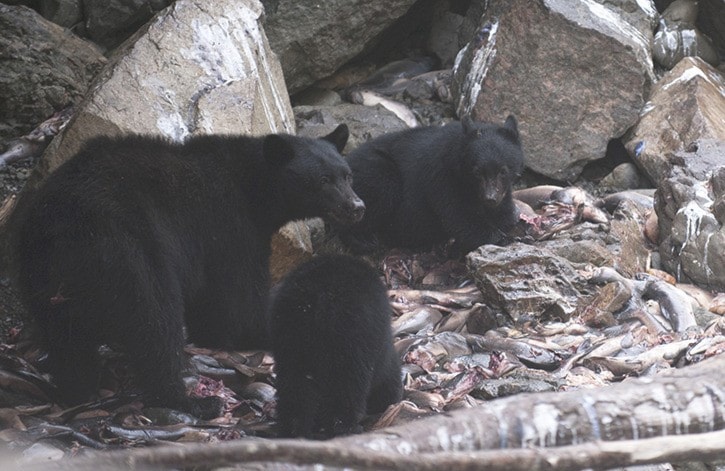PORT HARDY—The bizarre discovery of hundreds of dead fish in a dry stream bed last weekend left fisheries biologists at the nearby Quatse Hatchery puzzled, and alarmed at least one resident.
And while the long, dry summer just wrapping up on North Vancouver Island likely played a role in the die-off, it took a good, steady rain to create the conditions.
The fish, mostly pink salmon, were discovered in Dick Booth Creek, a small tributary of the Quatse River. They were photographed Sunday by local resident Dee Rambo, under and adjacent to a bridge near the entrance to the Sportsmen’s Rod and Gun Club along the Port Hardy-Coal Harbour Road.
“It’s called Dick Booth Creek, but locally it’s known as Dry Creek,” said Ken Fuller, manager of the Quatse Hatchery, which is located just a couple of kilometres downstream from the bridge. “And it is a dry creek. I spoke with one of the other workers here at the hatchery and, in all the time we’ve been here, we’ve seen very few pinks even travel in Dick Booth.”
Notified of the find but unsure of the location, Fuller first checked the series of bridges crossing the Quatse River itself before locating the carcasses under the crossing of Dick Booth Creek and reporting it to Fisheries and Oceans Canada (DFO).
Fuller noted Dick Booth is fed from the Nahwitti watershed to the west, while the Quatse is fed via Quatse Lake to the west. He theorizes a series of rainfalls in August on the Cains Lake Plateau filled Dick Booth Creek and the fish, riding the incoming tide up the Quatse River, turned into the creek rather than battle the shallower waters of the Quatse, which has experienced low levels throughout the dry summer.
“We did have a couple dumps of water (at Cain’s Lake) in mid- to late-August,” said Fuller. “What we’re speculating is that we had a rain event that didn’t put much water into the Quatse River main stem, but charged up Dry Creek.”
Then, when the rains backed off and Dick Booth reverted to its normal dry summer state, the salmon were trapped in an ever-shrinking pool until it ultimately evaporated.
“I’ve never seen this before in Dick Booth,” said Fuller. “This kill is hundreds and hundreds of fish. It’s an ugly scene, but it’s good for scavengers.”
It is not the first fish die-off this summer. Fuller said nearly 1,000 fish were lost earlier this summer in the Quatse, when they were trapped in a similar inter-tidal pool and quickly used up the limited oxygen available.
“DFO was also made aware of that,” said Fuller.
The fish carcasses in Dick Booth Creek, still silvery when photographed by Rambo Sunday, were already fading to brown and grey by Monday afternoon. They were providing a feast for crows, eagles, black bear and other scavengers, and Rambo was concerned the presence of the bears under and near the roadway could have public safety ramifications.
Fuller said the scavengers, bacteria and, if it comes soon enough, a good rain will eliminate the rancid fish. In the meantime, he regrets he did not learn about the entrapment of the fish while they were still alive, as Quatse Hatchery staff could have gathered them up as brood stock for egg retrieval.
As it is, continued low levels in the Quatse have already impacted the hatchery’s traditional brood collection.
“Traditionally, last week we’d have been taking brood stock,” Fuller said. “We still have low water giving me grief trying to start up our pumps.
“We’ve dealt with low-water issues all summer. I don’t think we’ve had a summer quite like this one with drought-like conditions.”
